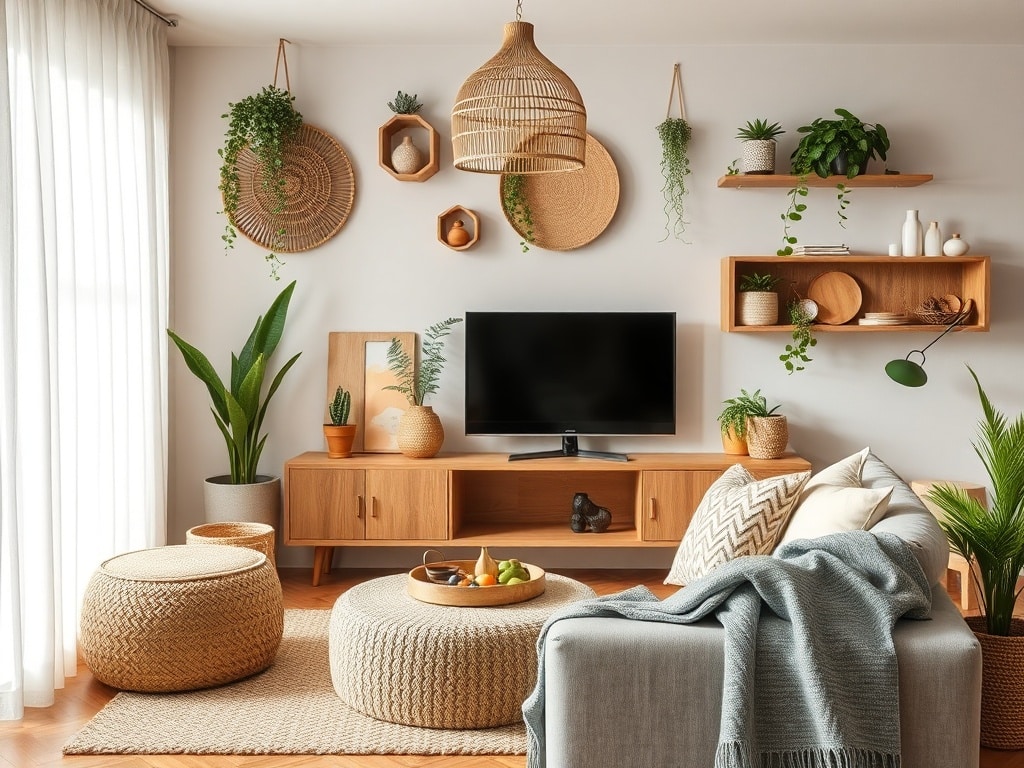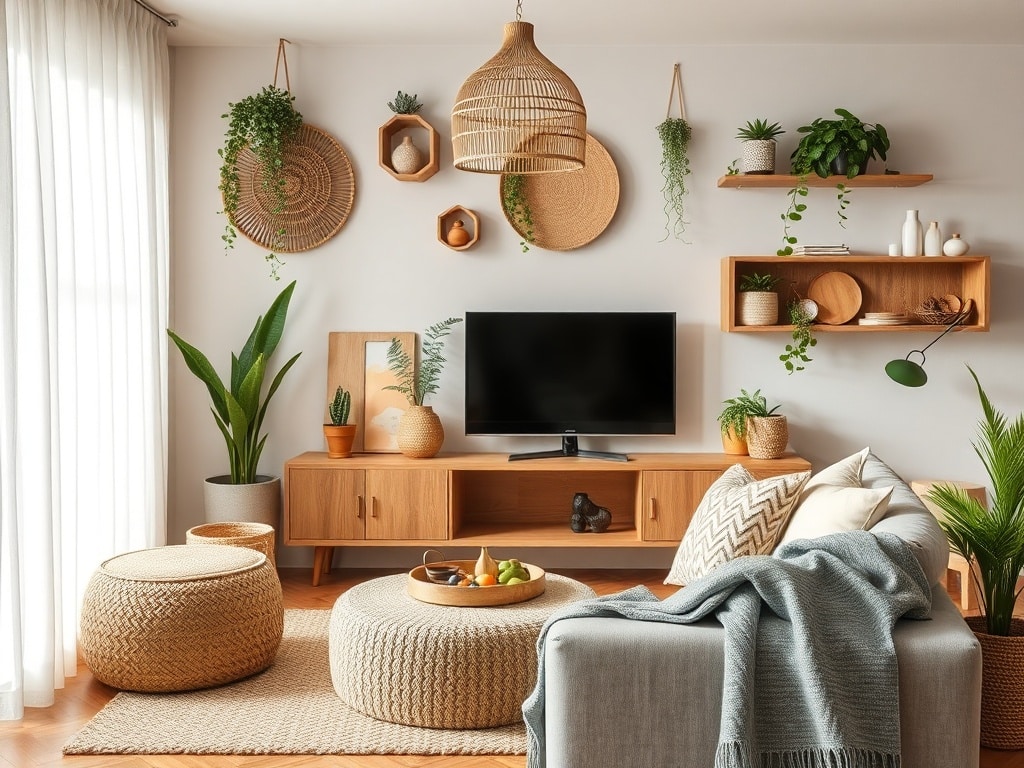Go Green, Live Luxe: The Ultimate Guide to Eco-Friendly Home Decor
What is Eco-Friendly Home Decor?
Eco-friendly home decor is about creating a beautiful and comfortable living space while minimizing your environmental impact. It involves selecting furniture, accessories, and materials that are sustainably sourced, non-toxic, and produced with minimal waste. Think of it as conscious consumerism applied to your home – making choices that are good for both you and the planet.
This approach goes beyond simply buying green products. It encompasses a holistic view of your home, considering factors like energy efficiency, indoor air quality, and the longevity of your decor items. It about investing in quality and eco-consciousness.
Why Choose Eco-Friendly Decor? (Benefits and Impact)
The benefits of choosing eco-friendly decor are multifaceted. From an environmental perspective, it reduces demand for virgin resources, minimizes pollution from manufacturing processes, and helps combat deforestation. By opting for sustainable materials, you're contributing to a healthier planet for future generations.
But the advantages extend beyond environmental concerns. Eco-friendly materials are often non-toxic and hypoallergenic, leading to improved indoor air quality and a healthier living environment for you and your family. Many sustainable pieces are also more durable, ensuring they'll last longer and reduce the need for frequent replacements.
Ultimately, choosing eco-friendly decor is a statement. It reflects a commitment to sustainable living and a desire to create a home that is both beautiful and responsible. When you buy quality, make it eco-friendly.
Sustainable Materials for Furniture and Decor
The foundation of eco-friendly home decor lies in choosing sustainable materials. Here are some top contenders:
- Bamboo: A rapidly renewable resource, bamboo is strong, versatile, and can be used for everything from flooring to furniture.
- Reclaimed Wood: Giving new life to old timber reduces demand for newly harvested wood and adds unique character to your home.
- Organic Cotton: Grown without harmful pesticides or fertilizers, organic cotton is ideal for bedding, curtains, and upholstery.
- Hemp: A durable and fast-growing fiber, hemp is a sustainable alternative to conventional textiles.
- Linen: Made from flax plants, linen is a breathable and biodegradable fabric that gets softer with age.
- Recycled Glass: Transforming waste into beautiful vases, countertops, and decorative accents, recycled glass adds a touch of elegance while reducing landfill waste.
- Cork: Harvested from the bark of cork oak trees, cork is a renewable and naturally fire-resistant material perfect for flooring or wall coverings.
Consider the entire lifecycle of each material, from sourcing to disposal, to make informed and sustainable choices.
Where to Source Eco-Friendly Furniture of Unmatched Craftsmanship?
Finding eco-friendly furniture that also boasts exceptional craftsmanship requires careful research. Look for companies and artisans who prioritize sustainability throughout their production processes. Some key factors to consider include:
- Certifications: Look for certifications like the Forest Stewardship Council (FSC) for responsibly sourced wood, or the Global Organic Textile Standard (GOTS) for organic textiles.
- Transparency: Choose companies that are transparent about their sourcing and manufacturing practices. Do they disclose where their materials come from and how their products are made?
- Local Artisans: Supporting local artisans and craftspeople reduces transportation emissions and helps preserve traditional skills.
- Durable Design: Invest in well-made pieces that are designed to last for years, reducing the need for frequent replacements.
Online marketplaces specializing in eco-friendly and ethically made goods are also great resources. Be sure to read reviews and research each seller before making a purchase.
Upcycled and Repurposed Decor Ideas
Upcycling and repurposing are creative ways to give new life to old items and reduce waste. Turn old ladders into bookshelves, vintage suitcases into side tables, or glass bottles into unique lighting fixtures. The possibilities are endless! Here's some additional repurpose inspiration:
- Pallet Furniture: Wooden pallets can be transformed into anything from coffee tables to headboards with a little creativity and elbow grease.
- Mason Jar Decor: Mason jars are incredibly versatile. Use them as vases, candle holders, or storage containers.
- Vintage Finds: Scour flea markets and antique shops for unique treasures that can be repurposed and given a new lease on life.
- Textile Transformations: Old t-shirts can be sewn into quilts, and worn-out jeans can be turned into storage baskets.
Upcycling not only reduces waste, but also adds a personal touch and unique character to your home.
DIY Eco-Friendly Decor Projects
Get your hands dirty and create your own eco-friendly decor! DIY projects are a fun and rewarding way to personalize your home while reducing your environmental footprint. Try these simple ideas:
- Homemade Candles: Make your own candles using soy wax, essential oils, and recycled jars.
- Natural Air Fresheners: Simmer citrus peels, herbs, and spices in water to create a natural and refreshing aroma.
- Plant Propagation: Propagate your favorite plants and share them with friends and family.
- Artwork from Nature: Create artwork using natural materials like pressed flowers, leaves, and twigs.
DIY projects allow you to control the materials used and ensure they are sustainable and non-toxic. Plus, you'll have a unique and personalized piece of decor that you created yourself.
Energy-Efficient Lighting Options
Lighting accounts for a significant portion of household energy consumption, so switching to energy-efficient options is a must for any eco-conscious homeowner. Here are some smart choices:
- LED Bulbs: LEDs use up to 75% less energy than incandescent bulbs and last much longer.
- Smart Lighting Systems: Smart bulbs and dimmers allow you to control your lighting remotely and optimize energy usage.
- Natural Light: Maximize natural light by keeping windows clean and using light-colored curtains and blinds.
- Task Lighting: Use focused task lighting instead of illuminating entire rooms to save energy.
By making the switch to energy-efficient lighting, you can significantly reduce your carbon footprint and lower your energy bills.
Eco-Friendly Paint and Wall Coverings
Conventional paints often contain harmful VOCs (volatile organic compounds) that can negatively impact indoor air quality. Opt for eco-friendly paints with low or zero VOCs. Look for paints made with natural pigments and plant-based binders.

For wall coverings, consider sustainable options like:
- Recycled Wallpaper: Made from recycled paper or textiles.
- Natural Fiber Wallpaper: Made from materials like grasscloth or bamboo.
- Clay-Based Paints: Natural paints with excellent breathability and moisture regulation.
Choosing eco-friendly paint and wall coverings ensures a healthier indoor environment and minimizes your impact on the planet.
Green Your Textiles: Organic Cotton, Hemp, and Linen
Textiles play a significant role in home decor, from bedding and curtains to upholstery and rugs. Choosing sustainable textiles is essential for creating an eco-friendly home. Opt for:
- Organic Cotton: Grown without harmful pesticides or fertilizers, organic cotton is soft, breathable, and gentle on the skin.
- Hemp: A durable and fast-growing fiber, hemp is a sustainable alternative to conventional textiles.
- Linen: Made from flax plants, linen is a breathable and biodegradable fabric that gets softer with age.
- Recycled Textiles: Look for rugs and other home textiles made from recycled materials like plastic bottles or reclaimed fibers.
When choosing textiles, consider factors like durability, breathability, and washability to ensure they meet your needs and last for years to come.
How to Maintain Your Eco-Friendly Home Decor
Proper maintenance can extend the lifespan of your eco-friendly decor and reduce the need for replacements. Here are some tips:
- Clean Regularly: Dust and vacuum regularly to prevent buildup and keep your decor looking its best.
- Use Eco-Friendly Cleaning Products: Avoid harsh chemicals that can damage your decor and pollute indoor air.
- Repair Instead of Replace: Repair damaged furniture or textiles whenever possible instead of throwing them away.
- Protect from Sun Damage: Use window coverings to protect furniture and textiles from fading and sun damage.
By taking good care of your eco-friendly home decor, you can enjoy it for years to come and minimize waste.
Common Misconceptions About Eco-Friendly Decor
There are several common misconceptions about eco-friendly decor that can deter people from making sustainable choices. Let's debunk a few of them:
- Myth: Eco-friendly decor is expensive. Reality: While some sustainable products may have a higher upfront cost, they often last longer and save money in the long run. Plus, upcycling and DIY projects are budget-friendly options.
- Myth: Eco-friendly decor is not stylish. Reality: There are countless stylish and sophisticated eco-friendly decor options available today. From modern minimalist designs to rustic farmhouse looks, you can create any style you desire with sustainable materials.
- Myth: Eco-friendly decor is difficult to find. Reality: While it may require some research, there are many retailers and artisans offering eco-friendly decor products. Online marketplaces and local craft fairs are great resources.
Don't let these misconceptions prevent you from embracing eco-friendly home decor. With a little knowledge and effort, you can create a beautiful and sustainable living space.
Budget-Friendly Eco-Decorating Tips
Eco-friendly decorating doesn't have to break the bank. Here are some budget-friendly tips:
- Shop Secondhand: Thrift stores, flea markets, and antique shops are treasure troves of unique and affordable decor items.
- DIY Projects: Create your own decor using recycled materials or natural elements.
- Upcycle Existing Items: Give new life to old furniture or accessories with paint, fabric, or other creative embellishments.
- Focus on Impactful Changes: Start with small, impactful changes like switching to LED bulbs or using eco-friendly cleaning products.
With a little creativity and resourcefulness, you can create a stylish and sustainable home on a budget.
Future Trends in Eco-Friendly Decor
The eco-friendly decor movement is constantly evolving, with new innovations and trends emerging all the time. Some future trends to watch out for include:
- Biophilic Design: Incorporating natural elements and patterns into interior spaces to promote well-being.
- Circular Economy: Designing products for disassembly and reuse, reducing waste and maximizing resource efficiency.
- Smart Home Technology: Using technology to optimize energy consumption and manage home resources more efficiently.
- Sustainable Material Innovation: Developing new and innovative sustainable materials from renewable resources.
As awareness of environmental issues grows, the demand for eco-friendly decor will continue to rise, driving innovation and creating new possibilities for sustainable living.
Eco-Friendly Cleaning Products for Your Home
Maintaining a clean home is essential, but conventional cleaning products often contain harsh chemicals that can harm your health and the environment. Switch to eco-friendly cleaning products made with natural ingredients like vinegar, baking soda, and essential oils.
You can also make your own cleaning products using simple recipes found online. Not only are they more sustainable, but they're also often more affordable.
Creating a Healthy Indoor Environment with Eco-Decor
Eco-friendly decor contributes to a healthier indoor environment by minimizing exposure to harmful chemicals and pollutants. By choosing sustainable materials, using low-VOC paints, and opting for natural cleaning products, you can create a living space that promotes well-being.
Additionally, incorporating indoor plants helps purify the air and create a more relaxing and inviting atmosphere.

